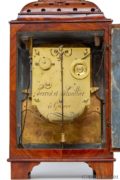A rare Swiss kingswood quarter repeating ‘pendule d’officier’, Terrot et Thuillier à Genéve, circa 1760
Description
The story
Clocks made for travel in the eighteenth century are rare. Since clocks were expensive, not many people could afford them, let alone an extra clock made especially for travel. The luxurious versions of these mostly individually made clocks are called ‘pendule d’officier’. This translates freely to ‘officer’s clock’, which is not strange, since army officers used clocks sometimes in their campaigns. But from the archives and bills that were preserved we know that not only officers but other nobility also used this type of clock for travel. The well-made movement of this clock is able to repeat the quarters on two bells when activated by pulling a cord. This was, of course, very useful in the night, since making light was difficult. One needed to make fire instead of just flipping a switch. Besides the repeating, this clock also has an alarm, also proving that this was used at the bedside. The beautiful craftsmanship is apparent in the intricate veneer and the well-executed dial. Although it was a clock designed for travel, today this clock will be a highlight in any interior and an object to admire and enjoy.
The dial
The engraved pewter chapter ring has Roman numerals and Arabic five minute marking. The alarm disc is made of silvered brass and the pierced hands of blued steel. De chapter ring is fitted to a gilt brass dial with matted centre and a chased foliate ornament below.
The movement
The movement is driven by a spring barrel and has a duration of over eight days. It is being regulated by a verge escapement in combination with a silk suspended pendulum. The clock has pull wind quarter repeating on two bells and a pull wind alarm. The backplate is signed Terrot & Thuillier à Genéve.
The case
The case is veneered with kingswood in cross banded patterns. The cushion shaped top has round and heart shaped holes for the sound of the quarter repeating. It is surmounted by a brass handle. The front and sides of the case are fitted with glass panels. The back has a paneled door. The whole is raised on bracket feet.
The makers
Philippe Terrot was a Hugenot whose family sought refuge in Geneva in 1700. He received citizenship in 1732 and worked there as clockmaker. Jean-Pierre Thuillier was a member of a Parisian clockmakers family who received citizenship of Geneva in 1754 together with his son.
Tardy; Dictionnaire des Horlogers Français, pp. 609 en 614.











